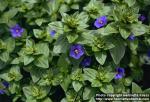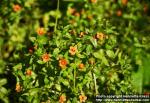
 The leaves of the Anagallis arvensis, Linné.
The leaves of the Anagallis arvensis, Linné.
Nat. Ord.—Primulaceae.
COMMON NAMES: Red pimpernel, Scarlet pimpernel, Red chickweed, Poor man's weather glass.
Botanical Source.—Anagallis arvensis is a beautiful annual trailing plant, growing in fields, roadsides, etc., introduced into this country from Europe. The stem, which is square, and more or less procumbent, is from 6 to 20 inches long, has elongated branches, or is simple, often dotted with purple. The leaves are sessile, ovate, many-ribbed, opposite or ternate, dotted with purple at the back; the peduncles longer than the leaves the sepals linear-lanceolate, about equaling the petals; the petals obovate, obtuse, longer than the stamens, and crenate-glandular. The flowers are opposite, small, but beautiful, with scarlet petals opening at 8 o'clock, a. m., and closing at 2 p. m.; in damp weather not open at all. The stamens are purple, hairy, dilated and smooth at the base. Anthers yellow and heart-shaped. Style purple and permanent. Stigma capitate. The capsule is pale and transparent, the size of a pea, separating all round, the valves marked with some indications of longitudinal separations which seldom take effect. The seeds are roughish, abrupt externally, each with a central dot.
History and Chemical Composition.—Red chickweed blossoms from May to August. The leaves are the parts used; they are odorless, but have a rough unsavory taste. Water extracts their virtues. A volatile oil, of the specific gravity 0.980, has been obtained from the dry plant. It has a harsh, pungent taste, and possesses a pronounced odor. Saladin, in 1830, announced that the unpleasant acrid bitterness of the leaves was due to cyclamin, a white, poisonous, crystalline principle, while Malapert, in 1857, believed it due to saponin. Ɣ In fact the plant here under consideration, has been usually substituted in Mexico for Saponaria officinalis. In 1891, Dr. Schneegaus obtained two glucosides identical with those from quillaja and senega (Amer. Jour. Pharm.). A ferment, active in digesting raw meat, has been found (1892) in it (Daccomo and Tommasi), stated to be a white, amorphous mass, soluble in water, with no action upon starch.
Action, Medical Uses, and Doses.—This plant appears to possess energetic properties, for according to Lindley, Orfila killed a dog by "making him swallow 3 drachms of the extract; upon examination it was found to have inflamed the mucous membrane of the stomach." Grenier obtained a similar result. The volatile oil in very small doses (4 drops) produced bodily pain, and persistent, violent "sick-headache." Its virtues are not fully known. It was considered an antidote to poison many years ago, and has more recently been employed to prevent the evil results arising from the bite of a rabid animal. Its internal use has been advised in mania, epileptic attacks, dropsical affections, and other derangements of the nervous system, but it should be employed with caution. It may, however, be used in form of poultice, as a local application to old and ill-conditioned ulcers. Dose of tincture (℥viij to alcohol, 50 per cent, Oj), from 1 to 5 drops.
Related Species.—Anagallis caerulea, Schreber. Blue pimpernel. Distinguished by blue flowers. It was thought by Linné a variety of red pimpernel. Its properties, chemically and medicinally, are probably analogous to those of Anagallis arvensis.

